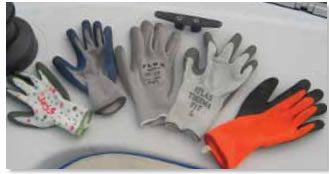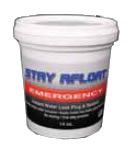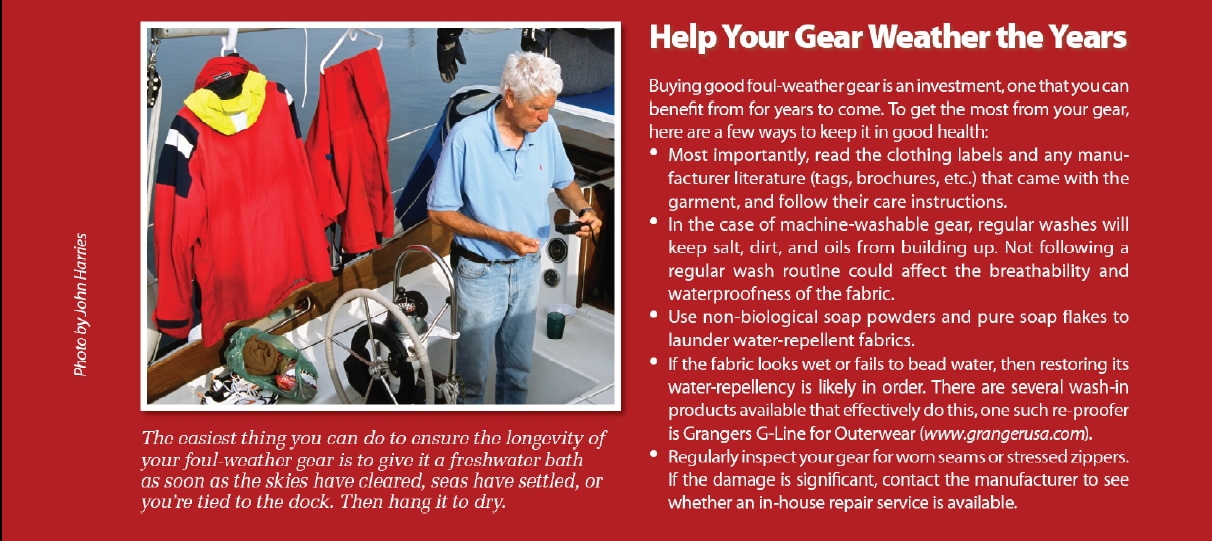
329
When temperatures drop or lines get soaked, a good pair of sailing gloves is key for safety and performance. Add in a dose of arthritis, and finding the best hand protection becomes a priority. We’ve tested and used all kinds of conventional sailing gloves (PS, March 2008, September 2008, and November 2008)— and we’ve noticed that most don’t really grab wet line for long.
Some years ago, two Olympic dinghy-sailing hopefuls found a solution that also happened to be cheap: PVC coated-palm work gloves. Designed for the rigors of construction and commercial fishing, they work well for line-handling and for nasty jobs like hauling muddy chain and cleaning the bottom. There are numerous brands available, and we’ve tried many. Durability is very similar, as is grip, and fit boils down to personal preference. The following are gloves that testers have found work the best and are readily available from hardware stores or online retailers.
Atlas Fit: Dinghy sailors generally use the Atlas gardening gloves, which fit snug. Most cruisers will be happier with the regular weight and a more comfortable fit. The Atlas Thermal glove offers some insulation and padding, but nothing like the freezer gloves.
Flex-Tuff-II: These offer the best value in this sort of work glove.
Global Glove: The comfortable Global Ice Gripster will keep your fingers warm anytime it’s relatively dry and not too far below freezing.
None of these are waterproof, but they dry fast. The cloth backs make them breathable summer gloves, but for cold, wet weather, there are better glove choices out there (See PS, November 2008).
All of the coated work gloves we tried excel at grabbing lines without slipping. The downside is they grab too well for easing line off a winch or coiling line. The sticky coating doesn’t wear well if you actively trim sails, with loaded lines sliding through your hands, but an active summer cruiser can expect to get at least a season out of the cheap gloves. Just remember to keep them away from chemicals like gasoline and DEET, or the palm coating will turn to goo in short order.
Bottom line
We recommend the Atlas, Flex-Tuff, and Global Glove. With prices ranging from just $2 to $8 per pair, buy one of each and decide which brand gets your pick. Keeping a pair handy will allow you to save your expensive sailing gloves from hard use.

329
Stay Afloat is an emergency repair sealant designed for stopping small leaks above and below the waterline. The non-toxic putty molds to fit most small holes, cracks, or gaps, even if submerged. According to the maker, you just remove the waxy putty from the tub and cram it into a hole or smear it over a crack until the leak stops.

Using a garden hose and a Jabsco Y-valve (to be featured in an upcoming test of Y-valves), PS tested Stay Afloat against typical plumbers putty. We found that although both will seal leaks under very low pressure, neither will be much help against the rush of water that can occur below the waterline, when a boat is pitching in a seaway. While our simple test was not a direct simulation of plugging a below-the-waterline leak, it gave us an idea of Stay Afloat’s tenacity and handleability. Stay Afloat was easier and faster to use than plumber’s putty, and it provided a stronger seal, but we wouldn’t put too much confidence in either product for below-the-waterline leaks. It is best to regard Stay Afloat as temporary relief from rain streaming through a mast-step or portlight, a quick plug for a puncture above the waterline, or a repair to a leaky sink drain.
Bottom line: Stay Afloat is not meant to replace wood plugs for through hulls or similar shoring/plugging products, like the foam Forespar TruPlug we reviewed in 2010. The moldable sealant is messy, but it quickly tames niggling, low-pressure leaks that can’t be easily stemmed by plugs or foam. In our view, it is probably worth the $15 (16 ounces) to keep a tub on hand for these types of small, temporary fixes.
329
Quality foul-weather gear can be expensive-in the $500 to $1,000 range for a full kit-so of course, youll want to take proper care of it to ensure that it holds up for the long haul. Sailing-apparel maker Gill recently launched a line of aftercare products designed to keep marine wear in top shape. Made in the UK, the product line includes an Intensive Spot Remover to target tough stains like grease and oil, a Wash-in Cleaner that kills bacteria and odors, and a quick-drying Reproofing Spray that replenishes the fabrics water- and stain-resisting abilities. While there are numerous products out there that will get fabrics clean, remove stains, and re-proof them, Gill claims its products are the first-ever marine-specific aftercare products.
PS tested the products on two heavy-weight foul-weather jackets (July 2008 issue) and two lighter-weight rain jackets. All of the jackets had seen multiple seasons of saltwater use, sported a few stains, and had not been laundered recently.
What We Found
The citrus-based Intensive Spot Cleaner has a pleasant orange smell. We first applied it to stains using a sponge and gentle rubbing as the directions advised, and when that didnt get the job done, we applied it with a toothbrush and scrubbing. The toothbrush was more successful, and we were able to clean two of three test stains.
We smeared used motor oil onto one jacket and let the stain set before applying the spot cleaner. It did a good job of removing the oil, but a fair amount of scrubbing was required. A few small grease stains on another jacket were no match for the spot remover and toothbrush, but a black mystery stain on one test jacket was unaffected by the combo.
We also attempted to clean mildew stains on a different jacket to no avail-this wasnt a big surprise as Gill makes no claim it will remove mildew.
Testers have always been cautious when laundering foulies-you never know which detergents may damage the fabrics breathability, or water and wind repellents-so we were excited that Gill formulated a detergent thats safe to use on waterproof and wicking fabrics and can be used in the washer or when handwashing. The Wash-in Cleaner washed away all of the salt stains on our test fabrics and left a neutral scent. Testers noted that a little goes a long way, and one bottle should last through about 10 loads. Spray tests with a garden hose confirmed that jackets retained their water-repelling ability after washing.
A few of our test jackets had lost their eagerness to shed water, so we coated them with the Gill Reproofing Spray and an inexpensive spray we found at Wal-Mart, Atsko Silicon Water Guard (803/531-1820, www.atsko.com). After the jackets dried, we spray-tested them with a hose to compare water-beading ability.
Both products were easy to apply and smelled like spray-paint, but the Gill spray (a Fluorinated polymer) dried much faster and its smell dissipated within minutes. The Atsko, however, left the treated fabrics wreaking of chemicals for days-it was not a smell you would want emanating from a V-berth hanging locker.
Neither product changed the color of the fabrics, and the initial greasy look the Atsko left quickly faded as the product dried. All of the reproofed jackets beaded water well in water-spray tests, but the Gill-treated fabrics tended to shed smaller beads. Gill claims its spray also gives fabric a salt and stain repellent finish, without affecting its breathability.

Bottom line
The products work, and wed definitely recommend adding the Wash-in Cleaner ($16 / 10 ounces) to your laundry kit. The Reproofer we liked much better than the Atsko brand-it was more effective and did not leave a chemical smell on the fabrics. However, the $23 (10 ounces) bottle was only enough to re-proof three jackets, and the $5
(10.5 ounces) Atsko was still 60 percent full after three applications. The spot remover is an average performer, but its price ($14 per 2.5 ounces) makes us reluctant to recommend it over a general spot-stain remover.
For tips on caring for foul-weather gear, check out this article online.





































